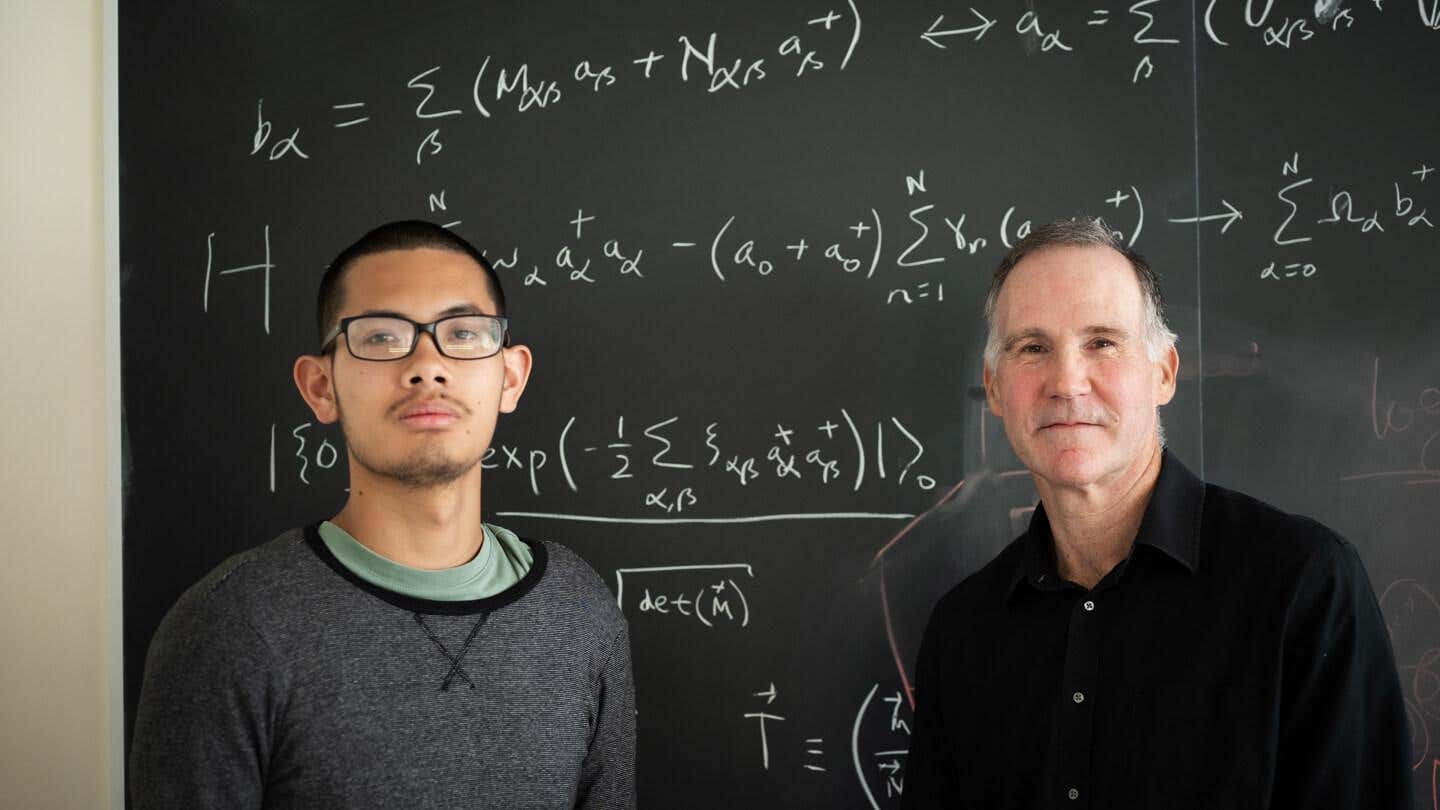Scientists solve 90-year-old mystery in quantum physics
When a guitar string is plucked or a playground swing is set in motion, the movement gradually fades away.

University of Vermont professor Dennis Clougherty (right) and his student Nam Dinh. (CREDIT: Joshua Brown/University of Vermont)
When a guitar string is plucked or a playground swing is set in motion, the movement gradually fades away. Physicists call these “damped harmonic oscillators,” and Newton’s laws do a fine job of explaining them in the everyday world.
But when you shrink that picture down to the scale of atoms, the rules change—completely. The strange behavior of the quantum realm doesn’t bend to Newtonian logic, and for nearly a century, scientists have wrestled with the question: can you have a quantum version of a damped harmonic oscillator?
University of Vermont physics professor Dennis Clougherty and his former student, Nam Dinh, have now found the answer. In work published in Physical Review Research, they present an exact solution for what they call a “damped quantum harmonic oscillator,” essentially the atomic-scale equivalent of a slowly fading guitar string.
It’s a problem researchers have been chasing for 90 years, and until now, no one had solved it without breaking one of quantum mechanics’ most important rules—Heisenberg’s uncertainty principle.
Bringing Lamb’s Model into the Quantum Age
The origins of this puzzle stretch back to 1900, when British physicist Horace Lamb studied how a vibrating particle embedded in a solid could lose energy to its surroundings. Using classical physics, Lamb showed that elastic waves created by the particle’s motion feed back into it, causing the vibration to weaken over time. It was an elegant explanation for energy loss—at least in the macroscopic world.
But translating Lamb’s work into quantum mechanics proved messy. At the atomic level, Heisenberg’s principle says you can’t know a particle’s exact position and momentum at the same time. Any attempt to model damping in quantum terms risked violating this limit. “To preserve the uncertainty principle, it’s necessary to include the interaction of the atom with all the other atoms in the solid,” Clougherty explained. That turns it into a many-body problem—one of the thorniest challenges in physics.
Related Stories
- Scientists use sound waves to unlock the secrets of quantum physics
- New unified gravity theory could finally bridge Einstein and quantum physics
Dinh, who earned both his bachelor’s and master’s degrees in physics at UVM before starting a PhD in mathematics, joined Clougherty in tackling the problem. With support from the National Science Foundation and NASA, they reformulated Lamb’s model to account for quantum behavior and found an exact solution.
The Math Behind the Breakthrough
The pair used a sophisticated approach called a multimode Bogoliubov transformation to reorganize the math describing the system. This method diagonalized the Hamiltonian—the equation that contains all the energy information about the system—and revealed that the ground state was something known as a “multimode squeezed vacuum.”
While that may sound abstract, the result is powerful. In such a state, uncertainty in one property, like position, can be reduced below the standard quantum limit by allowing more uncertainty in another, like momentum. This is the same principle that underpins the incredible sensitivity of gravitational wave detectors, which can measure distances a thousand times smaller than the nucleus of an atom.
Their solution also yielded a clear formula for the damping rate—the speed at which the atomic vibration fades—matching results from earlier approximations but with the bonus of being exact.
Why This Matters for Measurement and Sensing
One of the most intriguing parts of this research is its potential application. The model predicts how uncertainty in an atom’s position changes when it interacts with its surroundings. By carefully controlling these interactions, scientists could, in theory, reduce measurement uncertainty below what’s usually possible. That could lead to ultra-precise sensing devices—think of it as creating the smallest, most accurate measuring tape ever made, capable of probing quantum distances with unprecedented accuracy.
These squeezed states could also find use in fields like quantum acoustics, nanomechanics, and optomechanics, where vibrating structures on the scale of billionths of a meter interact with light or other particles. Devices inspired by this work could eventually help in quantum computing, communications, or navigation systems that rely on extreme measurement precision.
Revisiting the Past to Shape the Future
By solving Lamb’s original model in a quantum framework, Clougherty and Dinh have done more than just close a long-standing gap in theory—they’ve opened the door to experimental work that could bring these ideas into reality.
Their methods build on and extend earlier approaches by other scientists, such as the Caldeira-Leggett model for quantum dissipation and special cases studied by physicist Bernard Yurke. But where past efforts relied on simplifying assumptions, the Vermont team’s work preserves the full complexity of atomic interactions while still delivering an exact solution.
The implications are wide-ranging. In physics, some limits—like the speed of light—are fixed. But others, like the uncertainty in measuring a particle’s location, can be squeezed with clever techniques. By showing exactly how this can be done for a damped quantum oscillator, the team has added a new tool to the quantum measurement toolbox.
Past Studies and Findings
Early attempts to quantize the damped harmonic oscillator included the work of Feshbach and Tikochinsky, who introduced an auxiliary variable to mimic environmental effects. Caldeira and Leggett took a different route, splitting the system into the oscillator and its surroundings and then integrating out the environment’s influence. Bernard Yurke examined a variation of Lamb’s model involving a mass on a string connected to a spring, introducing new ways to deal with non-orthogonal modes.
In each of these approaches, simplifications were necessary, often sidestepping the full complexity of atomic interactions. While they provided valuable insights into dissipative quantum systems, none preserved the exact connection to the microscopic physics in the way the new University of Vermont model does.
Practical Implications of the Research
This breakthrough could be transformative for precision measurement. If you can reduce uncertainty in position beyond the standard quantum limit, you can create sensors of unmatched sensitivity. This could lead to advances in quantum metrology, allowing scientists to detect minuscule changes in position, pressure, or fields—capabilities crucial for everything from navigation without GPS to detecting gravitational waves from distant cosmic events.
It may also provide a better understanding of quantum friction and energy loss in nanoscale devices, helping engineers design more efficient quantum technologies. The same mathematics might even help improve systems in quantum computing, where controlling decoherence—loss of quantum information—is a major challenge.
Note: The article above provided above by The Brighter Side of News.
Like these kind of feel good stories? Get The Brighter Side of News' newsletter.



